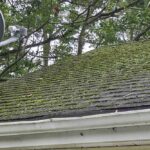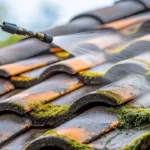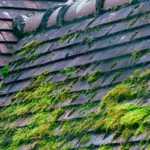As a homeowner, maintaining your property is a top priority. One aspect of home maintenance that often goes unnoticed is the presence of roof moss. While it might appear harmless, the energy cost impact of roof moss can be significant. In this article, we’ll delve into how roof moss affects your energy bills and what you can do about it.

What is Roof Moss?
Roof moss is a type of plant that thrives in damp, shady environments. It can quickly spread across rooftops, especially those in shaded or humid areas. While it may add a rustic charm to your home, it can lead to several issues, including increased energy costs.
How Roof Moss Increases Energy Costs
Insulation and Temperature Regulation
Moss can act as an insulator on your roof, disrupting the natural temperature regulation of your home. This leads to increased heating or cooling costs as your HVAC system works harder to maintain a comfortable indoor temperature.
Moisture Retention and Its Effects
The presence of moss can retain moisture, which can seep into your roof structure. This not only damages the roof but also affects the insulation, leading to higher energy consumption.
Maintenance and Prevention
Regular Cleaning
Regular cleaning of your roof can prevent the buildup of moss. For guidance on how frequently this should be done, you can refer to this roof moss cleaning frequency guide.
Professional Inspection
Hiring professionals for roof inspections can help identify moss growth early. This is especially important in coastal climates where moss growth is more prevalent.
DIY Solutions and Safety
For those interested in tackling moss removal themselves, understanding the dos and don’ts of roof moss removal can be beneficial.
Long-term Implications of Ignoring Roof Moss
Ignoring roof moss can lead to more than just increased energy costs. Over time, it can cause structural damage to your roof, which can be costly to repair. Additionally, it can affect the foundation of your home, as discussed in this article on foundation risks.
Environmental Considerations
Moss, while detrimental to roofs, plays a role in the ecosystem. It’s important to consider environmentally-friendly methods of removal to minimize impact on the surrounding environment. For more tips, you can visit this resource.
The Financial Aspect of Roof Moss Management
The cost of managing roof moss includes both prevention and maintenance expenses. Understanding these costs can help you budget effectively and avoid unexpected expenses. This is especially crucial for first-time homeowners.
Cost of Professional Services
Professional roof moss removal services can vary in price, but they offer expertise and efficiency. Weighing the cost against potential energy savings is essential.
DIY Cost Considerations
DIY methods can be cost-effective but require time, effort, and knowledge to execute safely and effectively.
Conclusion
Understanding the energy cost impact of roof moss is crucial for homeowners. By taking proactive measures, such as regular cleaning and inspections, you can prevent moss growth and reduce energy costs. Whether you choose professional services or DIY solutions, addressing roof moss promptly can save you money and extend the lifespan of your roof.

FAQs
1. How does roof moss directly affect energy costs?
Roof moss acts as an insulator, disrupting the natural temperature regulation in your home, which can lead to increased heating or cooling expenses.
2. Is it necessary to hire professionals for roof moss removal?
While not necessary, professional services offer expertise and can effectively prevent further damage and higher energy costs.
3. Can DIY methods effectively remove roof moss?
Yes, DIY methods can be effective if done correctly, but they require knowledge and safety precautions to ensure proper removal without damaging the roof.
This article contains affiliate links. We may earn a commission at no extra cost to you.








